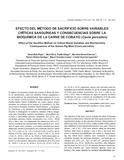Efecto del método de sacrificio sobre variables críticas sanguíneas y consecuencias sobre la bioquímica de la carne de cobayo (Cavia porcellus)

Visualizar/
Data
2012-03-05Autor
Palabras Clave
Aturdimiento, Desequilibrio acido-base, Características físico-químicas, Carne, CobayoStunning, Acid-base imbalance
Metadatos
Mostrar registro completoResumo
El objetivo del presente estudio fue evaluar el efecto del método
de aturdimiento, sobre las variables críticas sanguíneas y
su repercusión en las características físico-químicas de la carne
de cobayo (Cavia porcellus). Ochenta cobayos de la raza
Dunkin-Hartley fueron distribuidos en cuatro grupos experimentales:
los cobayos de los grupos G1 (Hembras) y G2 (Machos)
fueron aturdidos mediante desnucamiento, y los grupos
G3 (Hembras) y G4 (Machos) por insensibilización eléctrica.
Durante el desangrado se midieron variables críticas sanguíneas
para determinar cambios metabólicos, desequilibrio ácido-
base e intercambio gaseoso sanguíneo (pH, pCO2, pO2,
electrolitos, glucosa, lactato, hematocrito, tco2, HCO3
–, BE(B)
SO2c y thbc). Una vez refrigeradas las canales por 24 h a 2°C,
fueron evaluadas las características fisico-químicas (pH, retención
de agua, color y textura). Los machos aturdidos por insensibilización
eléctrica presentaron una tendencia hacia la acidez
(G2: 7,47 ± 0,03 vs. G4: 7,32 ± 0,03) (P<0,05). La pCO2, fué diferente
(P<0,05), entre grupos (G2: 35,00 ± 4,69 vs. G4: 54,00
± 5,04; G1: 34,00 ± 3,55 vs. G3: 53,00 ± 16,68) observando valores
más elevados para los aturdidos eléctricamente. En el
lactato se encontraron diferencias estadísticas (P<0,05) entre
G1: 18,00 ± 11,40 vs. G3: 62,40 ± 12,03 y G2: 27,50 ± 5,80 vs. G4: 76,20 ± 18,79, resultando valores más elevados para los
aturdidos con el método eléctrico. El pH de la carne fue menor
(P<0,05) para machos desnucados (G1: 6,12 ± 0,09 vs. G2:
5,95 ± 0,01). Para la retención de agua se aprecia un efecto
combinado del sexo y método de aturdimiento (P<0,05) entre
G1: 14,20 ± 0,57, G2: 13,75 ± 0,55 vs. G4: 11,35 ± 1,50.
Colecciones
Información Adicional
| Otros Títulos | Effect of the sacrifice method on critical blood variables and biochemistry consequences of the guinea pig meat (Cavia porcellus) |
| Correo Electrónico | dmota@cueyatl.uam.mx trujillortegame@yahoo.com.mx. |
| ISSN | 0798-2259 |
| Resumen en otro Idioma | The objective of this study was to evaluate the effect of stunning method on critical blood variables and their repercussions in four experimental groups on the physical-chemical characteristics of guinea pig meat (Cavia porcellus). Eighty Dunkin-Hartley guinea pigs distributed in four experimental groups were used. Those in groups 1 and 2 (G1 y G2) were stunned using the dislocation method, while those in groups 3 and 4 (G3 y G4) were subjected to electrical insensibilization (80 volts/5 s). During bleeding, the critical blood variables were measured to evaluate metabolic changes, the acid-base imbalance, and blood gas exchanges (pH, pCO2, pO2, Na+, K+ and Ca2+, glucosa, lactato, hematocrito, tco2, HCO3 –, BE(B) SO2c and thbc). After refrigerating the meat for 24 h at 2°C, its physical-chemical characteristics were evaluated (pH, water retención capacity, colour and texture). The males stunned by electrical insensibilization presented a tendency towards acidity. The values registered for the pH variable in males and females in the groups (G2: M = 7.47 ± 0.3 vs. G3: F = 7.37 ± 0.07) were significantly different (P<0.05). With respect to the variable pCO2, significant differences were found (P<0.05) between groups (G2: M = 35.00 ± 4.69 vs. G4: M = 54.00 ± 5.04; G1: F = 34.00 ± 3.55 vs. G3: F = 53.00 ± 16.68) with higher values registered in the animals stunned by electrical insensibilization, G3 and G4, than those stunned by dislocation, G1 and G2. With respect to lactate, statistical differences were found (P<0.05) in the variables in groups G1: F = 18.00 ± 11.40 vs. G3: F= 62.40 ± 12.03 and G2: M = 27.50 ± 5.80 vs. G4: M = 76.20 ± 18.79, which resulted in higher values for the animals stunned with electric current, G3 and G4, than those who were dislocated, G1 and G2. In terms of the pH variable of the meat, significant differences were found (P<0.05) by sex in the pigs that were dislocated (G1: F = 6.12 ± 0.09 vs. G2: M = 5.95 ± 0.01). Also significant differences were seen in the pH of the meat of the animals in G2: M vs. G3: F, due to effects of gender and stunning method. Turning to the variable of water retention, significant differences were found (P<0.05) between G1: F = 14.20 ± 0.57, G2: M = 13.75 ± 0.55 vs. G4: M = 11.35 ± 1.50, where a combined effect of sex and stunning method was observed. |
| Colación | 51 - 58 |
| Periodicidad | Bimestral |
| Institución | Universidad del Zulia (LUZ) Universidad de Los Andes (ULA) |
| Publicación Electrónica | Revista Científica |
| Sección | Revista Científica: Tecnología de Alimentos |





